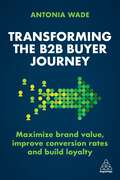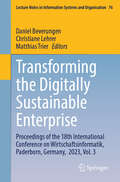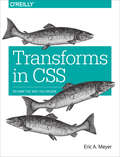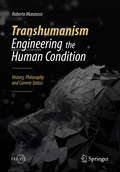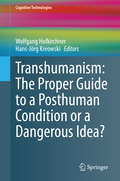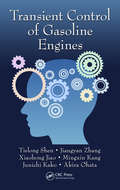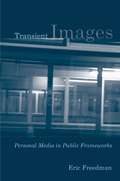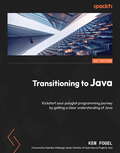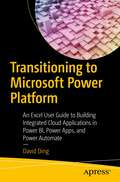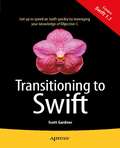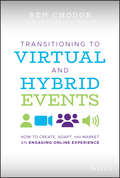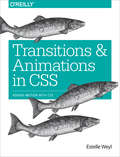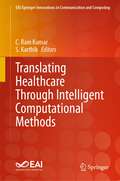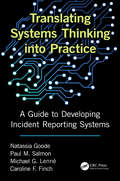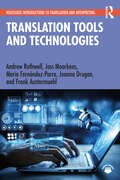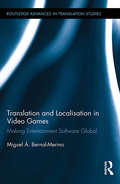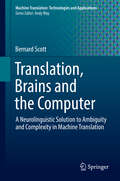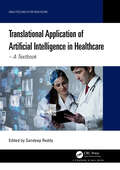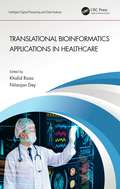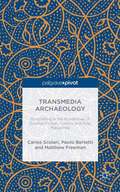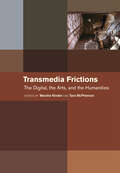- Table View
- List View
Transforming the B2B Buyer Journey: Maximize brand value, improve conversion rates and build loyalty
by Antonia WadeBoost lead generation, improve pipeline conversion and build loyalty with clients using this guide to designing a successful end-to-end B2B marketing buyer journey. Changes in B2B buying have heralded a new age of B2B marketing. Transforming the B2B Buyer Journey offers a new way of thinking that accommodates the many nuances in buyer behaviour. It provides a step-by-step guide to mapping the buyer journey, aligning channels, metrics and tactics according to their needs at each stage. The framework shows how to get more value out of brand investments, choosing and using technology and how to gauge return on investment. It also shows how to develop marketing as a real lever for business growth and how to reengineer marketing's relationship with sales. Written by a highly experienced and award-winning Chief Marketing Officer, as well as containing case studies and examples from organizations including PwC, Accenture, EY, Salesforce, ServiceNow and NCR, it features tips and templates as well as common pitfalls to avoid. This is an essential resource for ambitious B2B marketing professionals looking to achieve the competitive edge and change the traditional marketing relationship with buyers.
Transforming the Digitally Sustainable Enterprise: Proceedings of the 18th International Conference on Wirtschaftsinformatik, Paderborn, Germany, 2023, Vol. 3 (Lecture Notes in Information Systems and Organisation #76)
by Daniel Beverungen Christiane Lehrer Matthias TrierThis book is the third volume of proceedings from the 18th International Conference on Wirtschaftsinformatik held in Paderborn, Germany, in 2023. In the context of the global trend toward digitalization, it presents the results of innovative, high-quality research in the field of information systems and digital transformation. The book covers a broad range of topics, including digital innovation, business analytics, artificial intelligence, and IT strategy, each of which has and will continue to have significant impacts on companies, individuals and societies alike.
Transforms in CSS: Revamp the Way You Design
by Eric A. MeyerPresent information in stunning new ways by transforming CSS elements in two- and three-dimensional space. Whether you’re rotating a photo, doing some interesting perspective tricks, or creating an interface that lets you reveal information on an element’s backside, this practical guide shows you how to use them to great effect.Short and sweet, this book is an excerpt from the upcoming fourth edition of CSS: The Definitive Guide. When you purchase either the print or the ebook edition of Transforms in CSS, you’ll receive a discount on the entire Definitive Guide once it’s released. Why wait? Learn how to bring life to your web pages now.Create interesting combinations of 2D transforms and fully 3D-acting interfacesLearn two types of coordinate systems used in CSS transforms: the Cartesian coordinate system and the spherical systemUse the transform property to translate, scale, rotate, and skew an elementCreate the illusion of depth by adding perspective to an element—or one perspective to a group of elementsReveal the back of an element with the backface-visibility property
Transgression in Games and Play (The\mit Press Ser.)
by Kristine Jørgensen Faltin KarlsenContributors from a range of disciplines explore boundary-crossing in videogames, examining both transgressive game content and transgressive player actions.Video gameplay can include transgressive play practices in which players act in ways meant to annoy, punish, or harass other players. Videogames themselves can include transgressive or upsetting content, including excessive violence. Such boundary-crossing in videogames belies the general idea that play and games are fun and non-serious, with little consequence outside the world of the game. In this book, contributors from a range of disciplines explore transgression in video games, examining both game content and player actions. The contributors consider the concept of transgression in games and play, drawing on discourses in sociology, philosophy, media studies, and game studies; offer case studies of transgressive play, considering, among other things, how gameplay practices can be at once playful and violations of social etiquette; investigate players' emotional responses to game content and play practices; examine the aesthetics of transgression, focusing on the ways that game design can be used for transgressive purposes; and discuss transgressive gameplay in a societal context. By emphasizing actual player experience, the book offers a contextual understanding of content and practices usually framed as simply problematic.ContributorsFraser Allison, Kristian A. Bjørkelo, Kelly Boudreau, Marcus Carter, Mia Consalvo, Rhys Jones, Kristine Jørgensen, Faltin Karlsen, Tomasz Z. Majkowski, Alan Meades, Torill Elvira Mortensen, Víctor Navarro-Remesal, Holger Pötzsch, John R. Sageng, Tanja Sihvonen, Jaakko Stenros, Ragnhild Tronstad, Hanna Wirman
Transhumanism - Engineering the Human Condition: History, Philosophy and Current Status (Springer Praxis Books)
by Roberto ManzoccoThis book is designed to offer a comprehensive high-level introduction to transhumanism, an international political and cultural movement that aims to produce a “paradigm shift” in our ethical and political understanding of human evolution. Transhumanist thinkers want the human species to take the course of evolution into its own hands, using advanced technologies currently under development – such as robotics, artificial intelligence, biotechnology, cognitive neurosciences, and nanotechnology – to overcome our present physical and mental limitations, improve our intelligence beyond the current maximum achievable level, acquire skills that are currently the preserve of other species, abolish involuntary aging and death, and ultimately achieve a post-human level of existence. The book covers transhumanism from a historical, philosophical, and scientific viewpoint, tracing its cultural roots, discussing the main philosophical, epistemological, and ethical issues, and reviewing the state of the art in scientific research on the topics of most interest to transhumanists. The writing style is clear and accessible for the general reader, but the book will also appeal to graduate and undergraduate students.
Transhumanism: The Proper Guide to a Posthuman Condition or a Dangerous Idea? (Cognitive Technologies)
by Wolfgang Hofkirchner Hans-Jörg KreowskiThis book examines the contributions of the transhumanism approach to technology, in particular the contributed chapters are wary of the implications of this popular idea.The volume is organized into four parts concerning philosophical, military, technological and sociological aspects of transhumanism, but the reader is free to choose various reading patterns. Topics discussed include gene editing, the singularity, ethical machines, metaphors in AI, mind uploading, and the philosophy of art, and some perspectives taken or discussed examine transhumanism within the context of the philosophy of technology, transhumanism as a derailed anthropology, and critical sociological aspects that consider transhumanism in the context of topical concerns such as whiteness, maleness, and masculinity.The book will be of value to researchers engaged with artificial intelligence, and the ethical, societal, and philosophical impacts of science and technology.
Transient Control of Gasoline Engines
by Tielong Shen Jiangyan Zhang Xiaohong Jiao Mingxin Kang Junichi Kako Akira OhataCar electronics and digital processing technology have been used to improve the efficiency and performance of engines for decades, yet the main focus is still on static or pseudo-static mode, while the engines loaded in the road vehicles are not always operated at static mode. This book describes the behavior of engine dynamics operated at transient mode as a dynamical system, and uses advanced control theory to design a real-time control strategy that can be used to improve efficiency and emission performance.
Transient Images: Personal Media in Public Frameworks
by Eric FreedmanIn this probing study, Eric Freedman focuses on what images from photography, mobile communications, and the Internet reveal about looking. Exploring subjectivity by critically examining the look, he elaborates on the nature of the photographic frame and its relation to interpretive practices. Freedman scrutinizes what he calls "technobiography"—a life written through technology, and considers the movement of personal images into public spaces. He also considers authorship that situates the self as inherently engaged with and inscribed by information technology. All of the chapters in Transient Images explore Freedman's interest in examining how media technologies activate particular notions of self and community. He provides examples that address trauma—pictures of missing children on milk cartons and episodes of the reality series Intervention—as well as the strategies behind creating and distributing personal advertisements on the Internet. Transient Images draws out the tensions that exist in images circulating in the digital era.
Transition to Advanced Analytics: Get a Return on Your Analytics Investment
by Jason Tan Brian FerrisAmazon knows the products we’re interested in and shows us more to boost the size of our shopping cart. Google Maps knows the best route to get from A to B and recommends it to get us there in the shortest possible time. Netflix knows the media we enjoy most and recommends more to boost streaming time. However, many companies still fall short with their data analytics practices.This book focuses on how to embed advanced analytics directly into daily business operations and complement an enterprise system. This book can guide you in how traditional industries like retailers, banks and insurers can utilise and develop advanced analytics complementing their enterprise systems while embedding advanced analytics directly to optimise revenue and customer experience. Detailed in this book is a world-class analytics application used by loyalty point providers, banks, insurers and leading retailers.The title also provides a step-by-step implementation framework for Chief Digital and Artificial Intelligence Offices to develop their advanced analytics capabilities in tandem with legacy IT systems.
Transitioning to Java: Kickstart your polyglot programming journey by getting a clear understanding of Java
by Ken FogelDevelop your Java coding skills by exploring object-oriented methodologies, functional programming, software design patterns, and morePurchase of the print or Kindle book includes a free PDF eBookKey FeaturesGet started with programming in Java with this step-by-step guide for experienced programmersRe-enforce your knowledge of object-oriented methodologies applied in JavaDevelop the range of skills necessary for you to become a successful Java developerBook DescriptionThis comprehensive guide will help non-Java developers already using different languages transition from their current language to all things Java. The chapters are designed in a way that re-enforces a developer's existing knowledge of object-oriented methodologies as they apply to Java. This book has been divided into four sections, with each section touching upon different aspects that'll enable your effective transition. The first section helps you get to grips with the Java development environment and the Maven build tool for modern Java applications. In the second section, you'll learn about Java language fundamentals, along with exploring object-oriented programming (OOP) methodologies and functional programming and discovering how to implement software design patterns in Java. The third section shows you how to code in Java on different platforms and helps you get familiar with the challenges faced on these platforms. In the fourth section, you'll find out how you can manage and package your Java code. By the end of this Java programming book, you'll have learned the core concepts of Java that'll help you successfully transition from a different language to Java.What you will learnGain a solid understanding of the syntax in JavaExplore the object-oriented programming basics of the Java languageDiscover how to implement functions in JavaUnderstand which Java frameworks would be best for solving various problemsExplore creational, structural, and behavioral patterns in JavaGet to grips with server-side coding in JavaWho this book is forThis book is for anyone who is currently working with other programming languages and wishes to add Java to their skillset. Prior working experience as a developer using languages other than Java is expected, although no prior knowledge of Java is required.
Transitioning to Microsoft Power Platform: An Excel User Guide to Building Integrated Cloud Applications in Power BI, Power Apps, and Power Automate
by David DingWelcome to this step-by-step guide for Excel users, data analysts, and finance specialists. It is designed to take you through practical report and development scenarios, including both the approach and the technical challenges. This book will equip you with an understanding of the overall Power Platform use case for addressing common business challenges. While Power BI continues to be an excellent tool of choice in the BI space, Power Platform is the real game changer. Using an integrated architecture, a small team of citizen developers can build solutions for all kinds of business problems. For small businesses, Power Platform can be used to build bespoke CRM, Finance, and Warehouse management tools. For large businesses, it can be used to build an integration point for existing systems to simplify reporting, operation, and approval processes.The author has drawn on his15 years of hands-on analytics experience to help you pivot from the traditional Excel-based reporting environment. By using different business scenarios, this book provides you with clear reasons why a skill is important before you start to dive into the scenarios. You will use a fast prototyping approach to continue to build exciting reporting, automation, and application solutions and improve them while you acquire new skill sets. The book helps you get started quickly with Power BI. It covers data visualization, collaboration, and governance practices. You will learn about the most practical SQL challenges. And you will learn how to build applications in PowerApps and Power Automate.The book ends with an integrated solution framework that can be adapted to solve a wide range of complex business problems.What You Will LearnDevelop reporting solutions and business applicationsUnderstand the Power Platform licensing and development environmentApply Data ETL and modeling in Power BIUse Data Storytelling and dashboard design to better visualize dataCarry out data operations with SQL and SharePoint listsDevelop useful applications using Power AppsDevelop automated workflows using Power AutomateIntegrate solutions with Power BI, Power Apps, and Power Automate to build enterprise solutionsWho This Book Is ForNext-generation data specialists, including Excel-based users who want to learn Power BI and build internal apps; finance specialists who want to take a different approach to traditional accounting reports; and anyone who wants to enhance their skill set for the future job market.
Transitioning to Swift
by Scott GardnerDeveloping apps for Apple's broadening platform of devices is an exciting topic these days. Apple created the Swift programming language to build state-of-the-art apps using the latest Apple technologies. In this 200-page book, author Scott Gardner articulates the similarities and differences between traditional Objective-C based programming and Swift, revealing what you need to know from syntax changes to emerging best practices and paradigm shifts, to write powerful, expressive, and flexible code in Swift. Written at a brisk pace and in a methodical style, you'll learn how to apply your Objective-C skills to successfully transition to programming in Swift. In this book, you'll learn: - What is Swift and how does it compare to Objective-C- How to become proficient in Swift by leveraging your existing Objective-C skills- How to take advantage of new capabilities in Swift- What are the emerging best practices in Swift programmingTransitioning to Swift reaches out to all developers who are interested in creating state-of-the-art apps for Apple's broadening platform of devices for both consumers and enterprise. Apple's introduction of the new Swift programming language raises many questions. This book addresses those questions directly, and prepares developers for building the next generation of apps in Swift to surprise and delight users the world over.
Transitioning to Virtual and Hybrid Events: How to Create, Adapt, and Market an Engaging Online Experience
by Ben ChodorCreating virtual events is not as simple as moving the same content online — learn how to immediately leverage virtual solutions for effective in-person online events As the global COVID-19 pandemic continues to have unprecedented impact on both the global economy and the whole of the world population, the need for effectively and efficiently connecting people and the right information has never been more urgent. Although the technology infrastructure currently exists, many organizations are scrambling to create virtual meetings and events to address important time-sensitive issues. Transitioning to Virtual and Hybrid Events explains everything an event host needs to know about going virtual, from understanding the new audience, to adapting content to the new medium, to marketing effectively, and much more. Author Ben Chodor, president of Intrado Digital Media, provides expert advice and real-world instructions for delivering engaging hybrid, virtual, and streaming events and webinars for companies of all sizes and across all industries. Packed with detailed tutorials, real-world case studies, illustrative examples, and highly useful checklists, this comprehensive resource provides step-by-step guidance on: Planning, creating, and implementing a digital event Choosing between a stream, a webcast, or a hybrid event Evaluating different technological solutions Producing compelling virtual content for a variety of scenarios Effectively promoting online events Meeting the needs of a diverse and global audience Transitioning to Virtual and Hybrid Events is an indispensable instruction manual for anyone tasked with enhancing their organization’s continuity plans, enabling their employee base to work remotely, or creating any type of virtual solution to meet this urgent crisis.
Transitions and Animations in CSS: Adding Motion with CSS
by Estelle WeylAdd life and depth to your web applications and improve user experience through the discrete use of CSS transitions and animations. With this concise guide, you’ll learn how to make page elements move or change in appearance, whether you want to realistically bounce a ball, gradually expand a drop-down menu, or simply bring attention to an element when users hover over it.Short and deep, this book is an excerpt from the upcoming fourth edition of CSS: The Definitive Guide. When you purchase either the print or the ebook edition of Transitions and Animations in CSS, you’ll receive a discount on the entire Definitive Guide once it’s released. Why wait? Learn how to make your web pages come alive today.Understand and learn how to implement Disney’s 12 principles of cartoon animationLearn which CSS properties you can animate and use in transitionsApply CSS’s four transition properties and nine animation properties to your CSS elementsUse CSS keyframe animations to granularly control an element’s property valuesLearn details that will save you hours of debugging and megabytes of unnecessary JavaScript
Translating Healthcare Through Intelligent Computational Methods (EAI/Springer Innovations in Communication and Computing)
by C. Ram Kumar S. KarthikThis book provides information on interdependencies of medicine and telecommunications engineering and how Covid exemplifies how the two must rely on each other to effectively function in this era. The book discusses new techniques for medical service improvisation such as clear cut views on medical technologies. The authors provide chapters on processing of medical amenities using medical images, the importance of data and information technology in medicine, and machine learning and artificial intelligence in healthcare. Authors include researchers, academics, and professionals in the field of communications engineering with a variety of perspectives.
Translating Systems Thinking into Practice: A Guide to Developing Incident Reporting Systems
by Paul M. Salmon Natassia Goode Michael Lenne Caroline FinchSystems thinking tells us that human error, violations and technology failures result from poorly designed and managed work systems. To help us understand and prevent injuries and incidents, incident reporting systems must be capable of collecting data on contributory factors from across the overall work system, in addition to factors relating to the immediate context of the event (e.g. front-line workers, environment, and equipment). This book describes how to design a practical, usable incident reporting system based on this approach. The book contains all the information needed to effectively design and implement a new incident reporting system underpinned by systems thinking. It also provides guidance on how to evaluate and improve existing incident reporting systems so they are practical for users, collect good quality data, and reflect the principles of systems thinking. Features Highlights the key principles of systems thinking for designing incident reporting systems Outlines a process for developing and testing incident reporting systems Describes how to evaluate incident reporting systems to ensure they are practical, usable, and collect good quality data Provides detailed guidance on how to analyze incident data, and translate the findings into appropriate incident prevention strategies
Translation Quality Assessment: From Principles to Practice (Machine Translation: Technologies and Applications #1)
by Joss Moorkens Sheila Castilho Federico Gaspari Stephen DohertyThis is the first volume that brings together research and practice from academic and industry settings and a combination of human and machine translation evaluation. Its comprehensive collection of papers by leading experts in human and machine translation quality and evaluation who situate current developments and chart future trends fills a clear gap in the literature. This is critical to the successful integration of translation technologies in the industry today, where the lines between human and machine are becoming increasingly blurred by technology: this affects the whole translation landscape, from students and trainers to project managers and professionals, including in-house and freelance translators, as well as, of course, translation scholars and researchers. The editors have broad experience in translation quality evaluation research, including investigations into professional practice with qualitative and quantitative studies, and the contributors are leading experts in their respective fields, providing a unique set of complementary perspectives on human and machine translation quality and evaluation, combining theoretical and applied approaches.
Translation Tools and Technologies (Routledge Introductions to Translation and Interpreting)
by Andrew Rothwell Joss Moorkens Joanna Drugan María Fernández-Parra Frank AustermuehlTo trainee translators and established professionals alike, the range of tools and technologies now available, and the speed with which they change, can seem bewildering. This state-of-the-art, copiously illustrated textbook offers a straightforward and practical guide to translation tools and technologies. Demystifying the workings of computer-assisted translation (CAT) and machine translation (MT) technologies, Translation Tools and Technologies offers clear step-by-step guidance on how to choose suitable tools (free or commercial) for the task in hand and quickly get up to speed with them, using examples from a wide range of languages. Translator trainers will also find it invaluable when constructing or updating their courses. This unique book covers many topics in addition to text translation. These include the history of the technologies, project management, terminology research and corpora, audiovisual translation, website, software and games localisation, and quality assurance. Professional workflows are at the heart of the narrative, and due consideration is also given to the legal and ethical questions arising from the reuse of translation data. With targeted suggestions for further reading at the end of each chapter to guide users in deepening their knowledge, this is the essential textbook for all courses in translation and technology within translation studies and translator training. Additional resources are available on the Routledge Translation Studies Portal.
Translation and Localisation in Video Games: Making Entertainment Software Global (Routledge Advances in Translation and Interpreting Studies)
by Miguel Bernal-MerinoThis book is a multidisciplinary study of the translation and localisation of video games. It offers a descriptive analysis of the industry – understood as a global phenomenon in entertainment – and aims to explain the norms governing present industry practices, as well as game localisation processes. Additionally, it discusses particular translation issues that are unique to the multichannel nature of video games, in which verbal and nonverbal signs must be cohesively combined with interactivity to achieve maximum playability and immerse players in the game’s virtual world. Although positioned within the theoretical framework of descriptive translation studies, Bernal-Merino incorporates research from audiovisual translation, software localisation, computer assisted translation, comparative literature, and video game production. Moving beyond this framework, Translation and Localisation in Video Games challenges some of the basic tenets of translation studies and proposes changes to established and unsatisfactory processes in the video game and language services industries.
Translation, Brains and the Computer: A Neurolinguistic Solution to Ambiguity and Complexity in Machine Translation (Machine Translation: Technologies and Applications #2)
by Bernard ScottThis book is about machine translation (MT) and the classic problems associated with this language technology. It examines the causes of these problems and, for linguistic, rule-based systems, attributes the cause to language’s ambiguity and complexity and their interplay in logic-driven processes. For non-linguistic, data-driven systems, the book attributes translation shortcomings to the very lack of linguistics. It then proposes a demonstrable way to relieve these drawbacks in the shape of a working translation model (Logos Model) that has taken its inspiration from key assumptions about psycholinguistic and neurolinguistic function. The book suggests that this brain-based mechanism is effective precisely because it bridges both linguistically driven and data-driven methodologies. It shows how simulation of this cerebral mechanism has freed this one MT model from the all-important, classic problem of complexity when coping with the ambiguities of language. Logos Model accomplishes this by a data-driven process that does not sacrifice linguistic knowledge, but that, like the brain, integrates linguistics within a data-driven process. As a consequence, the book suggests that the brain-like mechanism embedded in this model has the potential to contribute to further advances in machine translation in all its technological instantiations.
Translational Application of Artificial Intelligence in Healthcare: - A Textbook (Analytics and AI for Healthcare)
by Sandeep ReddyIn the era of 'Algorithmic Medicine', the integration of Artificial Intelligence (AI) in healthcare holds immense potential to address critical challenges faced by the industry. Drawing upon the expertise and experience of the authors in medicine, data science, medical informatics, administration, and entrepreneurship, this textbook goes beyond theoretical discussions to outline practical steps for transitioning AI from the experimental phase to real-time clinical integration. Using the Translational Science methodology, each chapter of the book concisely and clearly addresses the key issues associated with AI implementation in healthcare. Covering technical, clinical, ethical, regulatory, and legal considerations, the authors present evidence-based solutions and frameworks to overcome these challenges. Engaging case studies and a literature review of peer-reviewed studies and official documents from reputed organizations provide a balanced perspective, bridging the gap between AI research and actual clinical practice.
Translational Bioinformatics Applications in Healthcare (Intelligent Signal Processing and Data Analysis)
by Nilanjan Dey Khalid RazaTranslational bioinformatics (TBI) involves development of storage, analytics, and advanced computational methods to harvest knowledge from voluminous biomedical and genomic data into 4P healthcare (proactive, predictive, preventive, and participatory). Translational Bioinformatics Applications in Healthcare offers a detailed overview on concepts of TBI, biological and clinical databases, clinical informatics, and pertinent real-case applications. It further illustrates recent advancements, tools, techniques, and applications of TBI in healthcare, including Internet of Things (IoT) potential, toxin databases, medical image analysis and telemedicine applications, analytics of COVID-19 CT images, viroinformatics and viral diseases, and COVID-19–related research. Covers recent technologies such as Blockchain, IoT, and Big data analytics in bioinformatics Presents the role of translational bioinformatic methods in the field of viroinformatics, as well as in drug development and repurposing Includes translational healthcare and NGS for clinical applications Illustrates translational medicine systems and their applications in better healthcare Explores medical image analysis with focus on CT images and novel coronavirus disease detection Aimed at researchers and graduate students in computational biology, data mining and knowledge discovery, algorithms and complexity, and interdisciplinary fields of studies, including bioinformatics, health-informatics, biostatistics, biomedical engineering, and viroinformatics. Khalid Raza is an Assistant Professor, the Department of Computer Science, Jamia Millia Islamia (Central University), New Delhi. His research interests include translational bioinformatics, computational intelligence methods and its applications in bioinformatics, viroinformatics, and health informatics. Nilanjan Dey is an Associate Professor, the Department of Computer Science and Engineering, JIS University, Kolkata, India. His research interests include medical imaging, machine learning, computer-aided diagnosis, and data mining.
Translational Bioinformatics and Its Application
by Qin Xu Dong-Qing Wei Yilong Ma William C. S. Cho Fengfeng ZhouThis book offers a detailed overview of translational bioinformatics together with real-case applications. Translational bioinformatics integrates the areas of basic bioinformatics, clinical informatics, statistical genetics and informatics in order to further our understanding of the molecular basis of diseases. By analyzing voluminous amounts of molecular and clinical data, it also provides clinical information, which can then be applied. Filling the gap between clinic research and informatics, the book is a valuable resource for human geneticists, clinicians, health educators and policy makers, as well as graduate students majoring in biology, biostatistics, and bioinformatics.
Transmedia Archaeology: Storytelling in the Borderlines of Science Fiction, Comics and Pulp Magazines
by Matthew Freeman Carlos A. Scolari Paolo BertettiIn this book, the authors examine manifestations of transmedia storytelling in different historical periods and countries, spanning the UK, the US and Argentina. It takes us into the worlds of Conan the Barbarian, Superman and El Eternauta, introduces us to the archaeology of transmedia, and reinstates the fact that it's not a new phenomenon.
Transmedia Frictions: The Digital, the Arts, and the Humanities
by Marsha Kinder and Tara McPhersonEditors Marsha Kinder and Tara McPherson present an authoritative collection of essays on the continuing debates over medium specificity and the politics of the digital arts. Comparing the term "transmedia" with "transnational," they show that the movement beyond specific media or nations does not invalidate those entities but makes us look more closely at the cultural specificity of each combination. In two parts, the book stages debates across essays, creating dialogues that give different narrative accounts of what is historically and ideologically at stake in medium specificity and digital politics. Each part includes a substantive introduction by one of the editors. Part 1 examines precursors, contemporary theorists, and artists who are protagonists in this discursive drama, focusing on how the transmedia frictions and continuities between old and new forms can be read most productively: N. Katherine Hayles and Lev Manovich redefine medium specificity, Edward Branigan and Yuri Tsivian explore nondigital precursors, Steve Anderson and Stephen Mamber assess contemporary archival histories, and Grahame Weinbren and Caroline Bassett defend the open-ended mobility of newly emergent media. In part 2, trios of essays address various ideologies of the digital: John Hess and Patricia R. Zimmerman, Herman Gray, and David Wade Crane redraw contours of race, space, and the margins; Eric Gordon, Cristina Venegas, and John T. Caldwell unearth database cities, portable homelands, and virtual fieldwork; and Mark B.N. Hansen, Holly Willis, and Rafael Lozano-Hemmer and Guillermo Gómez-Peña examine interactive bodies transformed by shock, gender, and color. An invaluable reference work in the field of visual media studies, Transmedia Frictions provides sound historical perspective on the social and political aspects of the interactive digital arts, demonstrating that they are never neutral or innocent.
